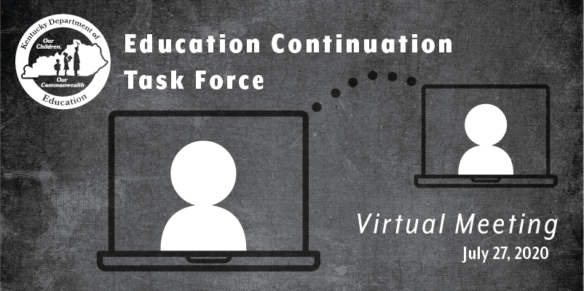
- One of the easiest ways for schools to add flexibility, according to KDE associate commissioner Rob Akers, is to utilize a digital learning provider to deliver content instruction.
- David Johnson, executive director of the Southeast/South-Central Education Cooperative, asked if any trainings would be made available for school staff on how to track participation.
By Jacob Perkins
jacob.perkins@education.ky.gov
At the Education Continuation Task Force’s July 27 meeting, members received an update from Associate Commissioner Rob Akers of the Kentucky Department of Education’s Office of Educator Licensure and Effectiveness, about teacher certification and permission flexibility ahead of the 2020-2021 school year.
“As our district leaders prepare to safely reopen school, we’re going to have to take some precautions to get people back in person,” said Akers. “That’s going to necessitate some flexibility for staffing and assignment of teachers.”
One of the easiest ways for schools to add flexibility, according to Akers, is to utilize a digital learning provider to deliver content instruction.
With a digital learning provider, any certified teacher can serve as the teacher of record to facilitate a course. In Infinite Campus, the district would need to mark the teaching method as a digital learning provider and the instructional setting as online or onsite classroom.
This option could be used when a school has a teacher who may be at high risk of contracting COVID-19 and is permitted to work remotely, said Akers.
“Understand that in this scenario, the teacher of record cannot be a substitute or an instructional aide,” explained Akers. “It has to be an actual certified teacher, but it can be any certified teacher.”
As long as the content already is developed for a course, a high school mathematics teacher, for example, could serve as the teacher of record for an elementary-level class.
The need for a teacher of record to design content, as well as an additional instructor to facilitate delivery, is a situation Akers believes will occur more in the middle and high school environments. This may occur due to classes where social distancing measures require the use of multiple classrooms.
The teacher of record must be certified to teach the content and the population of the course. However, any certified teacher can serve as an additional instructor.
“I understand that somewhere, depending on where you are, 75-85% attendance is about the limit of effective social distancing in some classrooms. So this is a consideration that schools need to be aware of,” said Akers.
As always, districts have the option to apply for emergency certification, said Akers. This would occur if a district needs a teacher to teach outside of his or her certification area and there are no other qualified candidates.
For an emergency certification, the district would need to submit an application to the Certification Branch. There is no fee for the application.
Akers added that KDE will continue to solicit input from partners to determine if there is a need to apply to the Education Professional Standards Board to consider additional waivers of regulations as the COVID-19 pandemic progresses.
“We know that superintendents and principals are going to need greater flexibility to staff their schools,” said Akers. “We know that teachers are going to do whatever it takes to step up to try and fill those gaps.”
COVID-19 Reopening Guidance on Food Service and USDA Waivers
Also on July 27, KDE released reopening guidance on food service operations and waivers for school meal programs. This guidance adds to the document released on June 22.
Lauren Moore, director of KDE’s Division of School and Community Nutrition, told the task force the new guidance will assist districts with planning for providing meals to students who are participating in U.S. Department of Agriculture (USDA) School Meal Programs and may be learning virtually for all or some of the 2020-2021 school year.
On June 25, 2020, the USDA released nationwide waivers for the upcoming 2020-2021 school year. These waivers provide schools with the flexibility to serve meals to their enrolled students outside of the traditional school setting.
Unlike waivers issued by the USDA in the spring at the onset of the pandemic, these waivers do not allow schools to serve meals through the summer feeding program models.
During the meeting, Kathryn Embree, KDE’s branch manager of the Division of School and Community Nutrition, provided details on the meal service models schools can operate when using these waivers.
The first is meal pick-up services, when a parent or guardian picks up meals at the school or meals are provided directly to the student.
Schools must have a method to count meals by individual students, collect payments when applicable and include internal control processes that would prevent duplicate meals being provided, said Embree.
Another method would allow schools to send meals home with a student during a traditional in-person instructional day for consumption the following day or on future days when the student would be learning through non-traditional instruction (NTI).
For this service, program operators must consider food safety, such as keeping hot meals hot and cold meals cold, when planning menus that would be transported home by students, said Embree.
The final model is a meal delivery service where schools would use their buses to deliver meals on their normal routes, at bus stops or directly to households.
Delivering meals directly to households requires schools to obtain handwritten permission from the household before delivery.
Participation Guidelines
David Cook, KDE’s director of innovation and coordinator of the NTI Program, gave a presentation on participation guidelines.
During the Kentucky Board of Education’s July 10 meeting, the board voted to provide additional flexibility to Kentucky school districts in the form of two emergency administrative regulations. One was an amendment to 702 KAR 7:125 that temporarily suspends the collection of student attendance data for funding purposes. In its place, it established a process for collecting student participation and requires the reporting and publication of district student participation rates to KDE and the Legislative Research Commission.
David Johnson, executive director of Southeast/South-Central Education Cooperative, asked if any trainings would be made available for school staff on how to track participation.
Cook said KDE is in the process of providing professional learning support with Kentucky’s education cooperatives through design labs.
“Those design labs will allow for the specific kinds of needs for the teachers in your districts as we start out this school year,” said Cook.
Updates from DPH
Dr. Connie White, deputy commissioner of the Kentucky Department for Public Health (DPH), told the task force the U.S. Centers for Disease Control and Prevention (CDC) updated its school reopening guidance on July 23.
White said while the changes are “nothing major,” there will be some changes to the state’s flagship Healthy at School guidance document.
“There was really not a lot of substantial changes and we’re going to create a one-page document to compliment the flagship document so that people can have the latest updated information,” she said.
Citing recent spikes in positive COVID-19 cases in Kentucky, Gov. Andy Beshear recommended on July 27 that schools postpone in-person instruction until the third week of August.
Interim Education Commissioner Kevin C. Brown told the task force that he doesn’t anticipate that playing a role in the reopening plans for many of Kentucky’s school districts.
“I don’t think that will affect many districts, however,” he said. “I think most districts have scheduled their first day, whether that be in-person, NTI or hybrid, in the last half of August or the first part of September.”
Other Topics Discussed
Task force members also heard from KDE Chief Digital Officer Marty Park on the Kentucky K-12 Virtual School Network.
KDE has been working alongside districts and the state’s educational cooperatives to better understand districts’ needs when it comes to virtual schools.
About 30 school districts either are in the initial stages of developing or have a fully developed virtual school program, said Park. These programs would have expanded enrollment, meaning they take in students from other districts as well.
Members of KDE’s Office of Special Education and Early Learning also discussed two new guidance documents released on July 20 – “COVID-19 Considerations for Reopening Schools for Exceptional Learners and Preschool Students” and “COVID-19 Considerations for Reopening Schools: Compensatory Education and Extended School Year Services.”
The Education Continuation Task Force will meet again on Aug. 10.
Previous coverage of the Education Continuation Task Force:
- KDE Education Continuation Task Force covers CTE, health and safety reopening guidance (July 13, 2020)
- First KDE advisory group offers feedback on Healthy at School guidance (June 29, 2020)
For more information about COVID-19:
- Kentucky Department for Public Health’s COVID-19 webpage
- KDE’s COVID-19 webpage
- COVID-19 Hotline (800) 722-5725



Leave A Comment